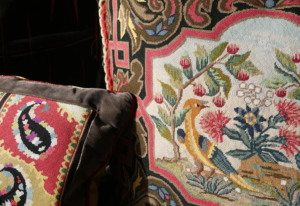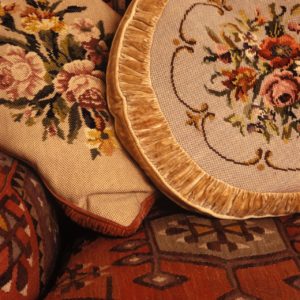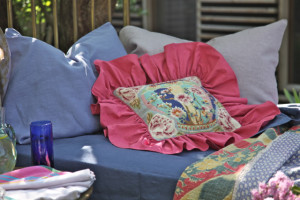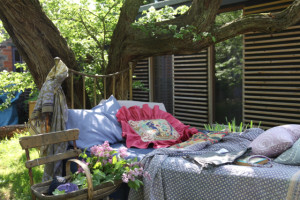A textile technique known as early as the ancient Egyptians, Hebrews and Greeks, which has played an significant role in European culture and economy.
Tapisserie of London hand-paint the most beautiful and elegant, bespoke tapestry canvases.
Tapestries as wall hangings to warm up stone walls and cover doors and doorways long predate wall papers and curtaining. When the king moved around the country and from house to house, the tapestries were rolled up and went with him. At Hampton Court, London we can see those that Henry VIII took with him…
1. Tapestry is traditionally needle worked onto a mesh, or if embroidery into calico, and made in panels that my be joined to create a larger piece- such as the world famous Bayeux tapestry, that hangs in France and was worked in England.
In hand worked ‘tapestry’ any embroidery stitchery can be used, however cross stitch, tent and satin stitches that lie close to one-another and cover the ground entirely, cover the ground completely. These designs follow a drawn outline and with coloured threads, creating decorative patterns and historical scenes.
Hand-made, or needle-point tapestries can be made large enough to cover sofas and chairs and for floor rugs, but this is rare simply because of the time and effort involved. Cushions and chair seats are usually quite enough, and occasionally we have been given sets of twelve to upholster. Over the years, several clients have presented us with their lifetime’s work, with which we have covered dining chair seats, made up as a floor rug or a series of cushions.
Lovely collections of hand worked tapestries can be found in churches, as hassocks hanging on the backs of pews, made by members of the congregation at all skill levels.
Clients tapestry that we set onto velvet borders, with a kelim covered sofa.
2. Fabrics that are tapestry – like, can be handwoven on a loom, in the piece, and more recently, tapestries have been woven using the Jacquard technology – which speeds up the process and although is not at all the same thing as a hand worked piece it effectively does the same job well, in far less time and at far less cost.
Lengths of handmade, cross stitched rugs from China and Arriaolas rugs of Portugal make very good upholstery fabrics and heavy duty curtaining.
3. Tapestry is now also a term used to describe heavy, stiff, multi-coloured fabrics woven in several layers to produce a hardwearing fabric, and used for heavy-duty upholstery and serious curtains. There are many such good designs made in Italy and France for curtaining and upholstery and available at almost any price level. The heaviest of these can be backed and bordered to make very good floor rugs.
For specially designed, hand painted tapestries as shown in the image at the top. https://tapisserie.co.uk/about/
Below- a fun Kaffe Fasset tapestry with an over-sized and over-the-top frill
For Kaffe Fasset and other tapestry kits:




